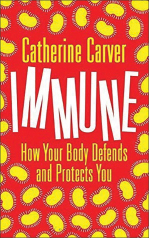Although the basic concept of using the body’s immune defense mechanisms to fight cancer has been around for centuries, the idea of using immunotherapy in cancer, in general, returned to prominence when Dr. Thomas Burnet first proposed the theory of cancer immunosurveillance in 1957. Despite promising research, it took decades for the field of immunotherapy to be accepted by mainstream oncology. Now it is the rage, and along with the scientific and medical enthusiasts come the authors, all eager to add their voice to the field of immunotherapy.
A Lively Style
A NEW ADDITION to the list of books dedicated to the promise of immunotherapy is Immune: How Your Body Defends and Protects You by science writer and immunologist Catherine Carver. Ms. Carver completed her first degree in natural sciences before studying medicine at the University of Aberdeen, which included time spent in Tanzania working with human immunodeficiency virus sufferers. Ms. Carver has published in multiple medical journals and blogs. This is her first book, and although a difficult read at times for the lay public, it’s a lucid and informative read for most of those in the medical field.
Ms. Carver organized her book in 12 cleverly titled chapters. Her writing style is lively and chock-full of well-placed metaphors and anecdotes, which helps readers without a solid science background navigate the complexities of the immune system and the things that both harm and help it protect us. The author lets readers know what they are in store for with the book’s opening:
“Staring at a measuring cylinder full of my own pee, I couldn’t help but feel the reality of being a Cambridge student wasn’t quite how I’d pictured it. I definitely imagined less urine and more ancient spires, swarms of bikes and formal dining with Nobel laureates.” She means to bring fun to hard science, and it mostly works.
Tackling the Complexities of the Immune System
“The author digs into the complexity of some of the new immunotherapy checkpoint inhibitors and ends with a terrific discussion about phage therapy.”—
Tweet this quote
CHAPTER ONE gives the reader a short but thorough peek into the immune system’s defense mechanisms, beginning with externals such as the skin, earwax, and tears. Although interesting, it doesn’t quite do enough setup work, as she plunges into how the body regularly encounters and combats pathogenic organisms and toxic molecules. Moreover, Ms. Carver could have spent a bit more time describing the all-important differences between the two interrelated innate and adaptive immune systems before diving into macrophages and prostaglandins. One of the best parts of her opening is an excellent section on natural killer cells.
At times, Ms. Carver tries too hard to connect with what she perceives as the lay audience, interjecting unnecessary pop culture schmaltz such as, “‘Ever neat assassins, natural killer cells have another method of inducing death that rivals Kill Bill’s Five Point Palm Exploding Heart Technique’ both in name and neatness: tumor necrosis factor super-family mediated cell death.”
Use of anecdotes is the best method to keep a heady science-oriented story from bogging down in complex jargon, and Ms. Carver succeeds in that pursuit. In a section about immune response and autoimmune disease, she segues into the grizzly Chinese practice of harvesting organs from freshly executed prisoners and feeding them to the highest payer on the black market. It is a cringe-worthy story of supply in which China executes significantly more prisoners than any other country in the world; it also has the greatest shortage of organs needed for transplantation. In 2011, China had more than one million people in need of a kidney, yet just over 5,000 received one. “With stats like that it’s not hard to understand why some people suggest that the ethically abominable black market in death row donors will be hard to stop,” writes the author.

A Short Trip to Cancer Land
THE ASCO POST readers will have to be patient, as Ms. Carver waits until late in the book, chapter 14, to discuss cancer and the immune system. Here she does a good job describing the oncogenic process and the six hallmarks of cancer. The chapter ends with an in-depth look at inflammation as well as several inflammatory conditions that serve as precursors to cancer, such as inflammatory bowel disease and hepatitis B or C. Naturally, the connection between inflammation and cancer raises the many interesting possibilities for novel treatments. Unfortunately, perhaps due to a lack of space or time, she didn’t push this exciting area of therapeutic promise far enough; instead she spent too long harping on the benefits, real and purported, of aspirin.
BOOKMARK
- Title: Immune: How Your Body Defends and Protects You
- Author: Catherine Carver
- Publisher: Bloomsbury Sigma
- Publication date: November 2017
- Price: $25.95, hardcover, 304 pages
Also, there seems to be too much on bacillus Calmette-Guérin, which culminates in a very soft ending: “The term cancer covers a gamut of diseases, some of which have a very hopeful prognosis and others that are deadly, but all of which are formidable opponents of the immune system.” Really? That’s not science writing, it’s filler, and she, or at least her editor, should have known better.
The book’s final chapter, “Clever Drugs,” the author digs into the complexity of some of the new immunotherapy checkpoint inhibitors and ends with a terrific discussion about phage therapy—one of the most exciting areas in our battle against the terrifying increase in antibiotic-resistant bugs, which can turn a scuffed knee into a deadly infection.
Despite her pension for kitschy literary tricks, Ms. Carver has delivered a thorough and interesting book on the immune system and more—one that is recommended for readers of The ASCO Post. ■

